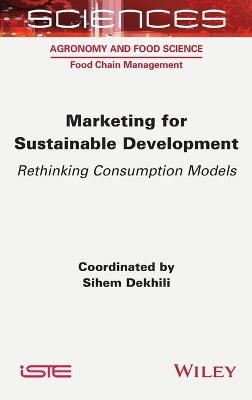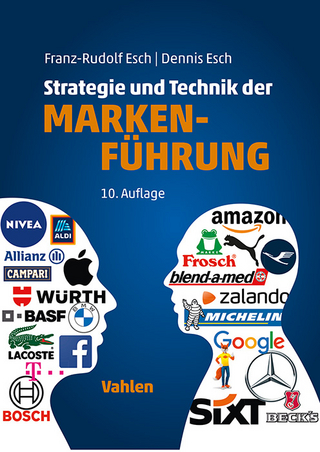
Marketing for Sustainable Development
Iste Ltd (Verlag)
978-1-78945-036-1 (ISBN)
In a context that is marked by crises and much skepticism, marketing today should, more than ever, prove that it acts in good faith. This book offers practitioners, public authorities, professors and students illustrations that demonstrate that the dissemination of sustainable practices is indeed a marketing issue. It argues that it is particularly important not only to overcome the divide between the concepts of marketing and sustainability, but also to use marketing tools and frameworks to support sustainable development and strengthen the green market.
Sihem Dekhili is a researcher in marketing at the BETA-CNRS laboratory at the University of Strasbourg, France. Her research focuses on responsible consumption, with topics related to eco-labeling, green communication, fair price and ethical fashion.
Contents
Foreword .
John THØGERSEN
Acknowledgments .
Sihem DEKHILI
Introduction .
Sihem DEKHILI
Chapter 1 Opposing the Market Through Responsible Consumption to Transform It 1
Abdelmajid AMINE and Mouna BENHALLAM
1.1 Introduction 1
1.2 Corporate adjustment strategies in response to the contestation of market logic 2
1.2.1 From an adaptive perspective of uprising recovery by the companies… 2
1.2.2 …to a transformative market logic under pressure from protest movements 4
1.3. Ideological and institutional categories of expressions of contestation 7
1.3.1 Towards a redesign of the dominant ideology of the market system 7
xiii
xvii
xix
1.3.2 Towards reestablishing a relationship of trust with the consumer 8
1.4 Pragmatic and operational categories of of market contestation 9
1.4.1 Towards a sustainable reconsideration of product offerings 9
1.4.2 Towards a necessary reconfiguration of supply and distribution channels 11
1.5 Conclusion and implications 13
1.6 References 15
Chapter 2 Luxury and Sustainable Development: Companies and the Challenge of Overcoming Consumer Reluctance 19
Mohamed Akli ACHABOU and Sihem DEKHILI
2.1 Introduction 19
2.2 The commitment of the luxury sector to sustainability: an unavoidable but risky strategic choice! 20
2.2.1 From luxury that wastes natural resources to “sustainable luxury” 21
2.2.2 Luxury companies and the challenge of sustainability 23
2.3 The perceived contradiction between luxury and sustainable development: origins and solutions 27
2.3.1 The sources of consumer reluctance towards sustainable luxury offers 27
2.3.2 What solutions are there for better integrating sustainable development into luxury? 30
2.4 Conclusion 32
2.5 References 34
Chapter 3 The Fight Against Food Waste: Approaches and Limits to Consumer-based Actions 37
Guillaume LE BORGNE, Margot DYEN, Géraldine CHABOUD and
Maxime SEBBANE
3.1 Introduction 37
3.2 Food chains under tension, food losing value 38
3.2.1 Food chains: the interactions and tensions of actors 39
3.2.2 Giving value back to food? 41
3.3 Consumer responsibility 42
3.3.1 Food standardization: An injunction to downgrade products? The case of fruit and vegetables 43
3.3.2 Combating waste at the consumer level, individualism and accelerated lifestyles: What are the contradictions? 44
3.4 Reducing food waste in mass catering 45
3.4.1 Separate, weigh, and inform: A winning strategy? 46
3.4.2 Towards a collective awareness of sectoral restrictions and the degree of consumer autonomy 47
3.5 Conclusion 50
3.6 References 52
Chapter 4 Food Waste in Family Settings: What are the Challenges, Practices and Potential Solutions? 55
Amélie CLAUZEL, Nathalie GUICHARD and Caroline RICHÉ
4.1 Introduction 55
4.2 The actors in family food waste: everyone is involved! 57
4.2.1. One family, one way of wasting: many families, many ways? .. 57
4.2.2 Role and perception of the main members of the family on food waste 61
4.3 Multifaceted wastage during family consumption at home 65
4.3.1 Managing shopping: a chronicle of foretold waste 66
4.3.2 Sorting and storing groceries 69
4.3.3 During meals: What about waste at the table? 71
4.3.4 Proposed anti-waste solutions for each stage of consumption 73
4.4 Conclusion: What about the future? 75
4.5 References 77
Chapter 5 The Packaging-free Product Market: A Renewal of Practices 79
Maud DANIEL-CHEVER, Élisa MONNOT, Fanny RENIOU and Lucie SIRIEIX
5.1 Introduction 79
5.2 The characteristics of packaging-free consumption 81
5.2.1 Where does the enthusiasm for packaging-free products come from? 81
5.2.2 Consuming packaging-free products 83
5.2.3. Motivations for and obstacles to packaging-free consumption 84
5.3 Offerings on the packaging-free product market 88
5.3.1 Positioning strategies of packaging-free product suppliers 88
5.3.2 The offering proposed and the range of products 92
5.3.3 The “logistics, distribution and merchandising” triptych for packaging-free products 94
5.3.4. Information support for consumers of packaging-free products .. 96
5.3.5 Revisiting the role of the seller 98
5.4 Conclusion 100
5.5 References 100
Chapter 6. The Conditions for Effective Social Communication .. 103
Agnès FRANÇOIS-LECOMPTE and Sylvie FOUTREL
6.1 Introduction 103
6.2 Social communication: a shifting reality 105
6.2.1 To say or not to say? 105
6.2.2 A triptych to be adapted to different situations 107
6.3 How can the credibility of communications be ensured? 108
6.3.1 Communicating using proof 109
6.3.2 Seeking out external guarantees 110
6.3.3 Getting others to talk about you 111
6.3.4 A long-term commitment 112
6.4 How can CSR provide added value to customers? 112
6.4.1 Choosing the adequate themes of communication 112
6.4.2 Translating social engagement into customer benefit 113
6.4.3 Choosing the right tone for communications 115
6.5 Conclusion 118
6.6 References 119
Chapter 7 The Effectiveness of “Provocation” in Environmental Advertising: Beware of “Greenbashing” 121
Sihem DEKHILI and Samer ELHAJJAR
7.1 Introduction 121
7.2 Greenbashing: clarification of a new concept 123
7.2.1 Advertising and contestation 123
7.2.2 Environmental advertising: from greenwashing to provocation 124
7.2.3 Greenbashing: what are the specificities of environmental advertising? 126
7.3 The effects of provocation on the effectiveness of environmental advertising 128
7.3.1 The empirical study: an experiment with consumers 128
7.3.2 Effect of provocation on the effectiveness of environmental advertising: mixed results 130
7.4 Conclusion 132
7.5 References 134
Chapter 8 How Can We Communicate Effectively About Climate Change? 137
Philippe ODOU, Marie SCHILL and Manu NAVARRO
8.1 Introduction 137
8.2 A gap between awareness and behavior 139
8.2.1 Awareness of the threat posed by climate change 139
8.2.2 Psychological obstacles to changing our modes of consumption 140
8.3 How can we communicate about climate change? 142
8.3.1 What kind of communication should be encouraged? 142
8.3.2 Which emotions should be focused on in the fight against climate change? 143
8.4 Mental representations of climate change among children 147
8.4.1 Engagement and representations of children relating to climate change 148
8.4.2 How can we talk to children about climate change? 149
8.5 Conclusion 153
8.6 References 154
Chapter 9 Environmental Regulations and Awareness-raising Campaigns: Promoting Behavioral Change through Government Interventions 157
Leila ELGAAIED-GAMBIER and Laurent BERTRANDIAS
9.1 Introduction 157
9.2 Overview of the environmental intervention tools of public authorities 159
9.2.1. Coercive environmental measures: the most radical approach .. 159
9.2.2 Ecotaxes and financial incentives: taxation as a dissuasion or an incentive 160
9.2.3 Environmental information, awareness-raising campaigns and persuasion: the crucial role of education 161
9.2.4 Green nudges: using behavioral science to serve environmental public policies 162
9.2.5 Towards an optimal regulatory mix 163
9.3 Improving the effectiveness of pro-environmental public policies: the contribution of marketing 167
9.3.1 Adopting a megamarketing approach to increase the chances of success of pro-environmental measures 167
9.3.2 Identifying competing legitimacies and mapping power structures 168
9.3.3 Understanding the cognitive patterns of individuals 169
9.3.4. Segmenting the “market” to optimize legitimization strategies .. 171
9.3.5 Establishing legitimization strategies: the crucial role of communication and education 172
9.4 Conclusion 174
9.5 References 176
Chapter 10 The Repairability of Household Appliances: A Selling Point for Utilitarian Products 179
Mickaël DUPRÉ, Patrick GABRIEL and Gaëlle BOULBRY
10.1 Introduction 179
10.2 Repairability: a complex concept 180
10.2.1 Beneficial political incentives 180
10.2.2 Environmental labeling: effects that are difficult to grasp 183
10.2.3 A limited selling point 184
10.3 The effects of a “repairability” label on purchasing behaviors: mixed results 187
10.3.1 The study: an experiment using fictitious e-commerce sites 187
10.3.2 Understanding labelR: a positive valence 188
10.3.3 The effects of the labelR on purchasing decisions: utilitarianism as a moderator 189
10.4 Conclusion 190
10.5 References 193
Chapter 11 The Role of the Fairtrade Label in the Spread of Sustainable Production and Responsible Consumption in West Africa: The Case of Côte d’Ivoire 195
Mantiaba COULIBALY-BALLET
11.1 Introduction 195
11.2 The Fairtrade label: towards sustainable production and responsible consumption 197
11.2.1 The position of the Fairtrade label: the quest for sustainable production 197
11.2.2 Fairtrade and responsible consumption: a label in search of legitimacy among consumers 203
11.3 The application of the Fairtrade label by producer organizations in Côte d’Ivoire: challenges and implications 207
11.3.1 Case study 207
11.3.2 Accompanying actions for producers: a source of sustainability and responsible consumption 208
11.4 Conclusion 213
11.5 References 213
Chapter 12 Mobile Apps and Environmentally Friendly Consumption: Typology, Mechanisms and Limitations 217
Adeline OCHS and Julien SCHMITT
12.1 Introduction 217
12.2 A typology of environmentally friendly mobile apps 218
12.2.1 Environmentally friendly consumption and mobile apps 218
12.2.2 The different stages of the purchase decision-making process of environmentally friendly products 221
12.3 The influence of mobile apps on behavior 228
12.3.1 The cognitive influence of mobile apps 228
12.3.2 The social influence of mobile apps 229
12.3.3 The emotional influence of mobile apps 230
12.4 What are the implications for the different actors in environmentally friendly consumption? 232
12.4.1 At the brand level: (re)learning how to communicate 232
12.4.2 Much needed regulation 234
12.4.3 Taking into account the potential negative effects of mobile apps 234
12.5 Conclusion 235
12.6 References 236
Chapter 13 Digitalization in the Service of Socially Responsible Consumption? Focus on Food Consumption 239
Christine GONZALEZ, Béatrice SIADOU-MARTIN and Jean-Marc FERRANDI
13.1 Introduction 239
13.2 The paradoxes of digitalization and sustainable food 241
13.2.1 What compatibility is there between digitalization and sustainable food? 241
13.2.2 A critical look at consumer responsibilization 244
13.2.3 The environmental impact of digitalization 246
13.3 Digital technology: a powerful tool 248
13.3.1 Successfully bringing about more responsible behaviors 248
13.3.2 A typology of digital tools according to their objectives 251
13.4 Conclusion 256
13.5 References 258
Chapter 14. Augmented Products: The Contribution of Industry 4.0
to Sustainable Consumption 261
Myriam ERTZ, Shouheng SUN, Émilie BOILY, Gautier Georges Yao QUENUM,
Kubiat PATRICK, Yassine LAGHRIB, Damien HALLEGATTE, Julien BOUSQUET
and Imen LATROUS
14.1 Introduction 261
14.2 Infrastructures and processes 265
14.2.1 Additive manufacturing and shifts in production paradigms 265
14.2.2 The Internet of Things in favor of the automated and remote management of products 269
14.3 Analytical capabilities 272
14.3.1 Big Data: a 360-degree knowledge of the product 272
14.3.2 Artificial intelligence and support for decision-making in managing the life cycle of products 276
14.4 Conclusion 277
14.5 References 282
Conclusion 285
Sihem DEKHILI
List of Authors 291
Index 295
Foreword
John THØGERSEN
Department of Management, Aarhus University, Denmark
Since the Industrial Revolution, humanity has been extremely successful in
combating diseases, producing a sufficient supply of food and other necessities and
adapting its environments to its needs. However, this success has a downside. The
boom in human production and consumption has led to planetary boundaries for safe
operating spaces being crossed in a range of areas, including climate change,
biosphere integrity, biogeochemical flows and land-system change. Humanity is
now so plentiful and powerful that our activities impact basic planetary functions.
This development is so radical that scientists speak about a new geological epoch:
the Anthropocene. Therefore, humans, for their own sake, must become stewards of
the planet and get us back into a safe operating space, while maintaining acceptable
ways of life, as expressed, for example, in the UN’s Sustainable Development
Goals. This is a major task and it is the government’s responsibility to organize and
regulate it. However, governments will not be able to prevail without the support
and active engagement of companies and the civil society as both consumers and
citizens.
Engaged citizens are a valuable source of knowledge and ideas for new norms
and regulations that are adapted to the national and local context. An informed
citizenry is also a prerequisite for achieving the necessary acceptance and support
for new regulations. In addition, changes in consumer behavior are a prerequisite for
many transformations, including the move from fossil to renewable energy, from a
linear to a circular economy, and to a more plant-based diet in industrialized
countries.
Marketing for Sustainable Development,
coordinated by Sihem DEKHILI. © ISTE Ltd 2021.
The scientific understanding of global challenges and technical solutions has
increased tremendously in recent decades, but knowledge and understanding of “the
demand side” is lagging behind. We need more knowledge and understanding of
citizen-consumers’ concerns, limitations, goals and wants with regards to new and
sustainable products, services and wider solutions, as part of a wide range of
sustainability transformations. We also need more knowledge of how to gain the
acceptance, support and engagement of the public, as citizens and consumers with
diverse values, needs, wants, resources and contexts.
For example, in developed countries, private households are responsible
for about a third of wasted food and about two thirds of plastic waste. Packaging
waste, most of which is discarded by households, creates significant problems in
nature. Therefore, consumers need to be actively engaged in closing the loops for
materials that pass through private households in huge volumes for the radical and
urgently-needed transformation from a linear to a circular economic model to
succeed. Marketing, as a discipline and practice, has accumulated experiences and
insights and developed effective tools to strengthen consumer acceptance of
recycled products or products made using recycled materials, and to increase the
amount and quality of waste materials that are reused or recycled from households.
This book coordinated by Sihem Dekhili is a welcome contribution to advancing
our knowledge and understanding of the role of the demand side for sustainable
development and especially about how to mobilize the tools, techniques and insights
of marketing for sustainable development. It offers a range of fresh perspectives on
sustainability transformations in the modern digital era, drawing on the creativity
and skills of a broad group of researchers. Like marketing in general, its main focus
is on individuals as consumers and on creating value for all parties in an exchange as
a means to achieve organizational and societal goals. This customer-centric
perspective of marketing may be the most important contribution to speeding up
sustainability transformations. However, marketing is not limited to commercial
exchanges and viewing people as individual consumers. Marketing has proven to be
an effective means for attaining massive changes in behaviors and lifestyles,
including making citizens aware of the need for sustainability transformations in
order to accept the required regulations. It is important to ensure consumers are
well-informed and understand and trust sustainable products, services and solutions,
both to convince them that it is worth their effort and help them to adopt more
sustainable goods and practices. Especially, marketing has refined effective tools to
help consumers make sustainable choices in supermarkets, including credible
sustainability labeling.
Mobilizing consumers and engaging them in sustainability transformations
requires a deep understanding of their diversity, and the ambiguity and conflicts
related to their goals. Some consumers resist the conventional market system and
experiment with various forms of simpler, sufficiency-oriented lifestyles. Others
make an effort to choose environmentally-friendly products and services. Still others
are environmentally concerned, but feel unable to do anything because they feel that
they lack credible environmental information or believe that the tradeoffs are
insurmountable. It is therefore important to differentiate between people with
different needs, wants, and abilities and to adapt regulation, education,
communication and solutions accordingly. More than any other discipline,
marketing has developed insights and effective tools for the segmentation and
targeting of consumers with different needs, wants, and abilities.
This book is a much-needed contribution to the understanding of the demand
side in sustainability transformations and especially of marketing as a force for
change towards sustainable development goals. It combines a solid foundation in the
accumulated insights of marketing with an appreciation of the specific challenges
and opportunities of the current age, including digitalization, mobile applications,
machine-to-machine communication and the Internet of Things. These new
technologies are rapidly changing our lives and when they are used well, they offer
new opportunities for supporting responsible consumer behavior and sustainability
transformations. This makes this book a useful resource for marketing scholars and
practitioners alike; indeed for everyone who is engaged in the sustainable
transformation of society, in companies, politics, NGOs and the civil society.
Acknowledgments
Sihem DEKHILI
CNRS – BETA, University of Strasbourg, France
The journey from an idea born several years ago to the production of this book
has been an extremely exciting adventure!
First of all, my warmest thanks go to the 41 authors of this book who have
shared my enthusiasm for the topic of responsible marketing and its role in
strengthening the sustainable development movement. The exchange of ideas and
discussions has been a source of great richness.
All of the authors have brought their expertise to the reflections within the
framework of a collective work that has been undertaken in a spirit of attentive
listening and conviviality. This kind of project makes the job of an academic even
more stimulating.
Huge thanks go to John Thøgersen for the Foreword, as well as for his
availability and great kindness. He is a renowned researcher, whose activities and
publications in the field of sustainable consumption are numerous.
I would also like to extend particular thanks to Jean-Marc Ferrandi and Patrick
Gabriel for their thoughtful advice.
Lastly, the aim of proposing a work anchored in action would have been
impossible without the numerous practitioners who offered their viewpoints and
Marketing for Sustainable Development,
enriched the analyses of the researchers. If only they could all be thanked here for
their precious contribution!
I hope the readers take as much pleasure from the reading of this book as its
authors did from creating it!
| Erscheinungsdatum | 06.01.2022 |
|---|---|
| Verlagsort | London |
| Sprache | englisch |
| Maße | 10 x 10 mm |
| Gewicht | 454 g |
| Themenwelt | Naturwissenschaften ► Chemie |
| Technik ► Bauwesen | |
| Wirtschaft ► Betriebswirtschaft / Management ► Marketing / Vertrieb | |
| Wirtschaft ► Betriebswirtschaft / Management ► Unternehmensführung / Management | |
| ISBN-10 | 1-78945-036-5 / 1789450365 |
| ISBN-13 | 978-1-78945-036-1 / 9781789450361 |
| Zustand | Neuware |
| Informationen gemäß Produktsicherheitsverordnung (GPSR) | |
| Haben Sie eine Frage zum Produkt? |
aus dem Bereich


